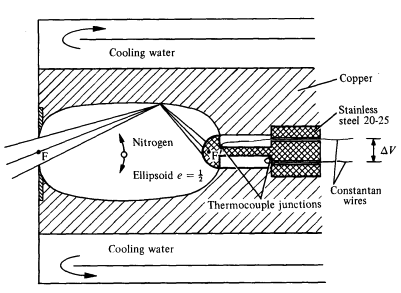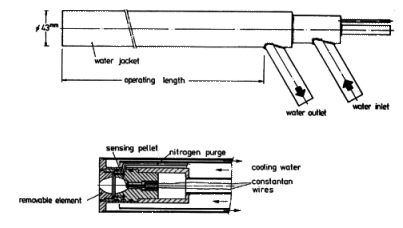-
How do I measure thermal radiation with an ellipsoidal radiometer?
Date posted:
-
-
-
Post Author
Neil Fricker
-
1. Background
The ellipsoidal radiometer is used to measure the total hemispherical radiative flux incident at a position corresponding to the front face of the radiometer. The information obtained using this instrument is of interest whenever the distribution and magnitude of radiative heat transfer is required near the boundary of the combustion chamber.
With care, traversing measurements through the flame are also possible. These provide additional information on the distribution of radiative properties within the flame.
2. Principle of the Ellipsoidal Radiometer
The principle of the ellipsoidal radiometer is illustrated in Figure 1 below.
The instrument consists of a water-cooled ellipsoidal cavity having an aperture at one focus and a thermopile at the other. The ellipsoidal cavity focuses all the radiation entering the orifice onto the surface of the thermopile. In order to minimise the radiation loss by absorption at the reflecting inner surface of the ellipsoid, the latter is plated with a thin (0.5 mm) layer of gold.
The thermopile is a heat flow plug of stainless steel with two thermocouple junctions at each end (constantan wire), which produces an e.m.f proportional to the energy absorbed at the pellet.
A small nitrogen purge is applied to the cavity to prevent the entry of furnace gases and particulates that would affect the mirror and the thermopile.

Figure 1 Principle of the ellipsoidal radiometer
3. Construction of the IFRF Ellipsoidal Radiometer
The construction of the IFRF ellipsoidal radiometer is illustrated in the lower part of Figure 2 below. The water jacket within which the instrument is mounted is shown in the upper part of Figure 2.
In the IFRF instrument, a protecting window is mounted within the ellipsoidal cavity to avoid damage to the thermopile and to eliminate errors due to convection. A purge flow of dry nitrogen (35-50 1/h) is injected on the orifice side of the window in order to prevent the entry of combustion gases. This purge flow must be carefully controlled when using and calibrating the instrument.
The response time of this instrument is long relative to the frequency of fluctuations of the total radiative flux, so that only steady state measurements are possible.

Figure 2: Construction of the IFRF ellipsoidal radiometer
4. Calibration
The instrument may be calibrated using black body furnaces. The temperatures of the black body furnaces should be chosen to reflect the range of radiative heat fluxes to be measured.
It is good practice to check the calibration before and after the instrument is used, or at regular intervals for a prolonged measuring campaign.
During calibration, the nitrogen purge must be applied at the rate to be used during the measurements. It is important to ensure that the purge nitrogen does not affect the temperatures and hence the output of the black body furnaces.
5. Where can I find out more about the ellipsoidal radiometer?
Advice is available to IFRF members from the IFRF Research Station. The Station can also supply calibrated probes to meet specific requirements.
Reference [2] contains a more detailed description of this measuring technique
Sources
[1] IFRF Doc No C76/y/13
[2] Chedaille J and Braud Y, Measurement in Flames, London, E Arnold, (1972)
